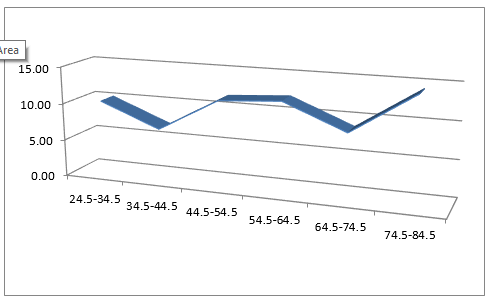Relationship between various indications and endoscopic findings in patients presenting to the tertiary care hospital in Peshawar
Abstract
Objective: To determine the relationship of various indications for upper GI endoscopy with the positive findings after endoscopic evaluation and biopsy.
Material and methods: prospective analytical study, at the department of medicine Kuwait Teaching Hospital Peshawar from 1st January 2015 till 31st December 2015. After approval from ethical research committee the study was conducted with patients recruited through non probability consecutive sampling presenting to the OPD.
Results: Among the total 1499 patients examined 18% were females and 82% were males. The data was stratified in to various age groups and the indications for endoscopy were assessed accordingly, the highest no. 78.7% (1180) presented with retrosternal burning, 38.8% (581) presented dyspepsia, 10.8% (161) presented with gastro esophageal reflux, 10.4%(156) has unexplained anemia, 10% (151) had persistent vomiting, (8.2%) 123 reported dysphagia, 6.3%(101) reported chronic diarrhea, and 2.2% (33) presented with hematemesis. endoscopy showed 43.5 % (651) with normal findings, 27.2% ( 407), pan hemorrhagic gastritis, 8.3% (124) reflux esophagitis, 6.2% (93) had gastric adenocarcinoma, esophageal carcinoma was found in 2.9 % (75). other findings were, H. Pylori gastritis in (33) 1.83%, esophageal candidiasis in (29) 2% of the cases, gastric ulcer in 24 (1.6%) , duodenal ulcer in ( 25) 1.6%, duedenitis in (12) 0.8%, achalasia in (9) 0.6%, duodenal growth in (5) 0.3% , Antral gastritis in (5) 0.3%, villous atrophy in 4 (0.26%) Barrett`s esophagus in (2) 0.1%, and drug induced ulcer in 0.06% (1). The result showed, age having no significant relationship with any of the indications whereas sex association showed Melena being common in males and GERD and unexplained abdominal pain in females. Results of Cohort study shows that symptoms like PMD, and Melena has a negative relationship with endoscopic findings suggesting a very limited role of these indications for a subsequent endoscopy ,Whereas dyspepsia, Anaemia, unexplained abdominal pain, Dysphagia, GERD and hematemesis are valid indicators as they bear a positive relationship with AEF.
Conclusion: . Symptoms like post-meal distension and melena found are misleading indications, whereas nonresponsive dyspepsia, unexplained anemia, unexplained abdominal pain, dysphagia, and GERD, and hematemesis are all valid indications for upper GI endoscopy.
Downloads
References
Di Giulio E, Hassan C, Marmo R, Zullo A, Annibale B.Appropriateness of the indication for upper endoscopy: a meta-analysis. B .Dig Liver Dis. 2010 Feb; 42(2):122-6.
Chiu PWY, Uedo N, Singh R, et al. An Asian consensus on standards of diagnostic upper endoscopy for neoplasia. Gut. 2019;68(2):186-197.
Appropriate use of gastrointestinal endoscopy. American Society for Gastrointestinal Endoscopy. Gastrointest Endosc. 2000 Dec; 52(6):831-7.
Drossman D, Corazziari E, Talley N, Thompson W, Whitehead W. Rome II: the functional gastrointestinal disorders: diagnosis, pathophysiology, and treatment; a multinational consensus. Second edition. Degnon Associates: McLean VA, USA; 2002.
Wallace M, Durkalski V, Vaughan J, Palesch Y, Libby E, Jowell P, et al. Age and alarm symptoms do not predict endoscopic findings among patients with dyspepsia: a multicentre database study. Gut. 2001;49(1):29–34.
Rabeneck L, Wristers K, Souchek J, Ambriz E. Impact of upper endoscopy on satisfaction in patients with previously uninvestigated dyspepsia. Gastrointest Endosc. 2003;57(3):295-299. doi:10.1067/mge.2003.122
Gyedu A, Yorke J. Upper gastrointestinal endoscopy in the patient population of Kumasi, Ghana: indications and findings. Pan Afr Med J. 2014;18:327.
Lippert E, Herfarth HH, Grunert N, Endlicher E, Klebl F. Gastrointestinal endoscopy in patients aged 75 years and older: risks, complications, and findings--a retrospective study. Int J Colorectal Dis. 2015;30(3):363-366. doi:10.1007/s00384-014-2088-3
Tachi K, Nkrumah KN. Appropriateness and diagnostic yield of referrals for oesophagogastroduodenoscopy at the Korle Bu Teaching Hospital. West Afr J Med. 2011;30(3):158-163.
Dronfield MW, Langman MJS, Atkinson M, Balfour TW, Bell GD, Vellacot KD, Amar SS, Knap DR. Outcome of endoscopy and barium radiography for upper gastrointestinal bleeding: control trial in 1037 patients. Br Med J. 1982;284:545–548.
Solanke TF. Upper gastrointestinal fibreendoscopy in Ibadan - an analysis of 205 consecutive procedures. Ghana Med J. 1978;17:95–97.
Nkrumah KN, Quartey-Papafio JB, Kawanishi M, Archampong EQ. Upper gastrointestinal endoscopy at the Korle-Bu Teaching Hospital. Ghana Med J. 1980;19(2):96–98.
Peterson WL, Barnett CC, Smith HJ, Allen MH, Cobett DB. Routine early endoscopy in upper-gastrointestinal-tract bleeding. The New Eng J Med. 1981;304(16):925–929.
Blatchford O, Davidson LA, Murray WR, Blatchford M, Pell J. Acute upper gastrointestinal haemorrhage in the west of Scotland: case ascertainment study. Br Med J. 1997;7107:510–514.
Wong RF, Khosla R, Moore JH, Kuwada SK. Consider colonoscopy for young patients with hematochezia. J Fam Pract. 2004;53(11):879-884.



























